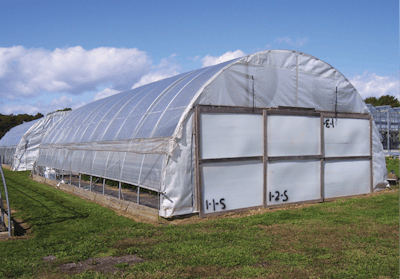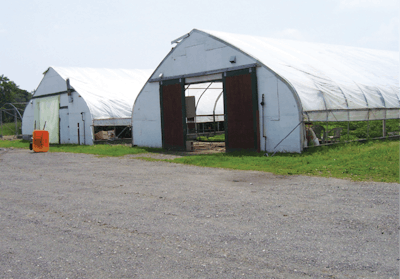Planning should be your first step in developing a framework for an orderly greenhouse build-out. Start with a facilities master plan that looks at topography and drainage, the building locations, parking for customers and staff, access for vehicles and equipment, and utilities (including water supply and electricity).
Facilities Layout
1. Because materials handling is one of the largest costs in a greenhouse operation, major consideration should be given to placement of a new greenhouse and its relation to the headhouse. A headhouse is the key nerve center that houses the work area, office, germination and growth rooms, utility area, processing, shipping and storage. Typically, a headhouse makes up 10 percent to 20 percent of the total greenhouse space.
2. The selection of a plant-moving system is important in relation to the plants grown, distance moved and elevation differences. Conveyors, carts and pallet trays have advantages and disadvantages that you should evaluate.
3. A master plan can also help in obtaining zoning, wetlands and building permits. You should submit the master plan with the initial phase of any multiphase build-out or expansion. This then becomes part of the approval process. If commission membership and sentiments change, the expansion phases are already on file.
4. Expansion space should be planned for all areas. It is best to create the plan on paper so that several alternatives can be evaluated. Greenhouses are large, modular erector sets, and expansion is easy if planned in advance. Fuel supply, electricity, water service and headhouse layout should be sized with expansion in mind.
Greenhouse Style
5. A free-standing greenhouse can have a quonset (hoop), Gothic or gable roof shape. Gothic designs are the most popular as they provide higher light transmission and shed snow more easily. A-frame design is standard when glass will be used for glazing. The free-standing design is usually the best choice for the small grower planning on less than 10,000 square feet of growing space. It is easy to build additional greenhouses as more space is needed. A separate growing environment can be provided in each house. Individual greenhouses can also be shut down when not in use. Free-standing greenhouses are generally less expensive to build, as site preparation and erection costs are less.
6. Growing space greater than 10,000 square feet is best provided by a gutter-connected greenhouse. Individual bays vary in width from 12 feet to 30 feet and have a clearance of 12 feet to 20 feet at the gutter. Bays can be constructed to achieve the desired width. The greenhouse can also be built in modular sections when more growing area is needed. Lengths up to 300 feet are available. A gutter-connected greenhouse offers the greatest flexibility. A taller gutter height is better as it provides an air buffer and room for an energy truss and energy/shade screen. Heat can be centralized, and heating costs are as much as 25 percent less than an equal area in free-standing greenhouses. Utilities are centralized and easier to install.
7. Glass glazing will give the highest light transmission (about 90 percent), but has the greatest heat loss. When the greenhouse is fitted with one or two energy screens, the heat loss is about the same as double-poly (two layers of 6 mil film plastic separated by air from a small blower) or twin-wall polycarbonate (a rigid material that has ribs between two layers of rigid plastic). Taxes on a greenhouse covered with low-cost, four-year poly are generally less than one with more permanent material. A glazing that diffuses the light will provide more uniform coverage and deeper penetration into the plant canopy.
Space Utilization
8. A peninsula-style bench arrangement will allow for more growing space than the traditional long benches. It also allows separation of individual plant varieties. The main aisle down the center of the greenhouse or bay should be wide enough to allow two carts to pass (usually 5 feet to 6 feet wide, but may be up to 10 feet wide in a gutter-connected greenhouse). Perpendicular side aisles can be 18 inches to 24 inches wide.
9. Movable benches can increase usable growing space to as much as 90 percent of your total greenhouse space. These can be set up near the floor to give maximum plant height area or at 30 inches above the floor to give convenient working height. One 20-inch to 24-inch work aisle is all that is needed.
10. To save valuable greenhouse growing space, mother plants and early vegetative growth can be done in separate rooms in the headhouse. Good temperature, humidity and lighting control can provide the ideal environment.

Heating
11. With energy being one of the largest cost items in production, installing high-efficiency heating is extremely important.
12. Compare heating fuels on a cost per million-BTU (British thermal unit) basis. Natural gas is usually the least expensive, but can cost more when the demand charge for the summer months is added in. Some growers have found that installing propane heaters to handle peak demand will lower total heating cost.
13. A hot water boiler is the best choice for a heating system. Water temperature can be modulated to meet the needs of air or root-zone systems at different times of the year. Distribution can be low-cost, water-to-air unit heaters or fin pipe radiation. Hot air unit heaters and furnaces work well for greenhouses that may be closed for winter.
14. Heating the bottom of pots, the floor or under the benches can provide uniform root-zone temperature, allowing air temperature to be lower. This saves fuel. A natural gas- or propane-fired domestic hot-water heater or an instantaneous in-line water heater works well for small greenhouses. Distribution can be performed with cross-linked polyethylene (PEX) or ethylene propylene diene monomer rubber (EPDM) tubing, or low-output fin radiation under the benches. It is best to limit this type of heat to no more than 25 BTU/sq. ft., as excessive drying of the growing mix can occur otherwise. Water temperature should not exceed 110°F. In cold climates, air heat provides the difference.
Energy/Shade Screens
15. A reduction of up to 50 percent in fuel costs can be achieved with the installation of an energy/shade screen. This movable screen is closed at night to retain heat. During the summer, it provides shade to lower plant-leaf temperature and save electricity from less fan operation. A 40-percent to 60-percent shade with 50-percent energy savings is a common material used for cannabis production.

Cooling
16. A fan and louver system will provide the most positive ventilation. Although more expensive to operate than a natural ventilation system, it will provide better temperature control. The system should be designed to give a ventilation rate of about 2 cubic feet per minute (cfm)/sq. ft. of floor area during the winter and 8 cfm/sq. ft. during the summer. Several stages of ventilation capacity with multiple fans are best. Select the largest diameter fans with the smallest motors to get the lowest electricity consumption (cfm/watt). Evaporative cooling, either fan-and-pad or fog can lower inside temperature by up to 20°F during the summer.
17. Natural ventilation through side and roof vents can be effective if sized properly. Side vents should measure between 15 percent and 25 percent of the floor area. The same applies for roof vents. If insect screening is required, a larger area is needed in side and roof vents, as screening will reduce airflow.
18. A horizontal air flow (HAF) system provides good air movement, uniform temperatures and reduces disease potential. Use 1/10 horsepower 12-inch- to 20-inch-diameter fans. Spacing depends on fan design, but fans should provide a minimum air-mass speed of 100 feet/minute for adequate air circulation.
Controls
19. If individual thermostats are used for the heating and cooling systems, select those that have a +/-1ºF differential (meaning the temperature can only swing 1 degree from the setpoint). This will give better temperature control and save energy. A better choice is to use an electronic controller that will integrate the heaters, fans, evaporative cooling system, irrigation system and supplemental lights. Many controllers also have temperature and power alarm features to warn cultivators of problems within the grow environment. Computer control is best for multiple greenhouses or several sections in a gutter-connect greenhouse.
Supplemental Lighting
20. To overcome variable weather conditions and still meet a production schedule, some supplemental lighting is usually needed. High pressure sodium (HPS) and light-emitting diode (LED) fixtures are the most efficient. As cannabis is a short-day plan—with a total daily light integral (DLI) of 30 to 40 moles of sunlight plus supplemental light that has to be accumulated within 12 hours—you may have to install 500 µmols to 600 µmols of supplemental lighting to achieve this. Have the lighting-equipment supplier design the fixture layout using its computer program to get adequate intensity and uniform coverage for your location.
Irrigation
21. Automated watering can save considerable labor. The system should be designed to provide uniform watering. Drip systems, either individual emitters for container crops or tape for crops grown in beds, are usually the best choice. (More water is wasted with overhead sprinklers as water goes between the containers and also runs off the leaves.) A large number of plants can be irrigated at one time on a small water supply due to the low flow rate. Adding one or more injectors can provide fertigation. This can be either a portable unit with integral concentrate tank or a central location in the headhouse with storage for the mixing tanks and fertilizer.














